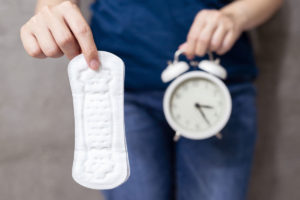Have you ever wondered what an average menstrual cycle looks like, and whether your cycle is healthy? PMS, irregular periods, and hormonal imbalance are increasingly common today, and they all have an impact on menstrual cycle health.
The four phases of the menstrual cycle
The menstrual cycle is divided into four distinct phases:
Menstruation
The first day of menstrual bleeding marks the first day of the menstrual cycle. Bleeding may last from 4-8 days, and signals the start of the follicular phase.
Follicular phase
Estrogen rises as the egg matures and prepares to be released. This phase lasts 14 days or more on average, or until ovulation begins.
Ovulation
Luteinizing hormone (LH) surges and triggers the release of this month’s ripe egg. The ovulation window lasts 12-24 hours, or the life of the egg.
Luteal phase
Progesterone is the dominant hormone following ovulation. This phase is known as the luteal phase. It lasts for 12-24 days and leads to menstruation, or the start of a new menstrual cycle.
What does normal look like?
The main players involved in the menstrual cycle are these hard-working hormones: estrogen, progesterone, follicle stimulating hormone (FSH), and luteinizing hormone (LH). When all is in order and every organ in the female body cooperates to create menstrual harmony, cycles are regular and reliable. This is all thanks to the fine-tuned processes governed by the HPAO axis, which stands for the system that connects the hypothalamus-pituitary-adrenal-ovaries feedback loop.
However, increased stress, poor nutrition and toxins wreak havoc on the menstrual cycle, with big consequences for sexual and reproductive wellness. During the average menstrual cycle, the fertile window lasts about 7-10 days and peaks at ovulation. In fact, women are only fertile for 14 ours on the day of ovulation. The fertile window shows that sexually active women may become pregnant from intercourse for up to 10 days prior to ovulation. But menstrual cycle irregularities, hormone imbalance, and wayward levels of estrogen and progesterone disrupt all of this.
Menstrual cycle irregularities
Common irregularities that play havoc with women’s menstrual cycle today may include:
- Overly short (under 21 days) or overly long (over 40 days) cycles
- Irregular cycles that change in length from one month to the next
- Breast tenderness
- PMS
- Uterine fibroids
- Estrogen or progesterone dominance
While hormonal contraception and birth control pills are often prescribed as a quick fix to menstrual irregularities, they only mask the problem with the help of synthetic hormones. The monthly bleeding that occurs on hormonal birth control is known as a ‘breakthrough bleed’ rather than a real menstruation. Birth control pills cannot regulate your period, but a solid nutritional and herbal plan absolutely can.
Causes of menstrual cycle irregularities include:
- Hormonal imbalance
- Polycystic Ovarian Syndrome (PCOS)
- Uterine fibroids
- Endometriosis
- Pelvic inflammatory disease
- Poor nutrition & stress
Other causes of period irregularities are believed to be linked to pollution and toxins, most specifically the endocrine disruptors found in plastics, pesticides, and other widespread consumer products.
A preventative approach
A great place to start for many women looking to prevent menstrual irregularities and take charge of their menstrual wellness include cycle charting, hormone testing, and a solid supplement regimen.
Start cycle charting
Want to know for sure when you ovulate, and ensure your hormones are working optimally during the four phases of the menstrual cycle? Cycle charting involves taking your waking temperature every morning. Temperatures are lower during the follicular phase and higher during the luteal phase. The temperature change between the two highlights the date of ovulation.
Test your hormones
Get your hormone levels tested at the lab for a full breakdown of your thyroid function, reproductive hormones, testosterone, FSH, LH and prolactin.
Make a solid supplement regimen
The right nutrient protocol and herbal support goes a long way in ensuring your menstrual cycle remains healthy as you age. Here are some expert nutrient and herb highlights.
- Indole-3-carbinol (I3C): A health-enhancing compound found in cruciferous vegetables, I3C promotes a healthy female reproductive function thanks to its liver-supporting power that helps clear excess estrogen.
- Magnesium: The humble mineral magnesium plays myriad roles in the health of the menstrual cycle. When paired with vitamin B6 and vitamin D, magnesium plays a role in the reduction of PMS symptoms, period pain, and PCOS.
- Vitex: Also known as chasteberry, this hormone-balancing herb is best indicated in the presence of estrogen excess and a short luteal phase.
- Black cohosh: This herb is beneficial for period pain and cramping, as well as soothing menopausal symptoms.
Find these in an all-in-one formula you can count on – Healthy Hormones.
Your menstrual cycle changes as you age
Changes in menstrual cycle function are normal throughout life. Hormonal contraception, pregnancy, breastfeeding, and menopause all affect the menstrual cycle. No matter where you are on your menstrual journey, it’s possible to find balance!


